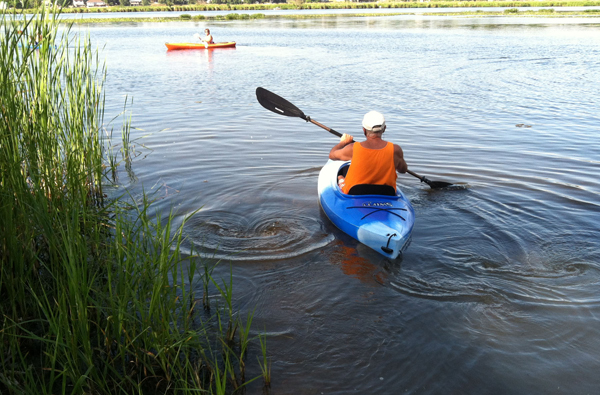By New York Sea Grant Launch Steward Kyle L. Teufel
New York Sea Grant 2012 Launch Stewards Program
Contact: Mary Penney, NY Sea Grant, E: mp357@cornell.edu, P:315-312-3042
Non-motorized boaters experience our local waters in a unique way. They're close to the water, slower moving, and, often times, very familiar with the launch sites and trails that they frequent. This familiarity allows them to see when a drastic change occurs in the environment, such as the arrival of a new aquatic invasive species.
Upon arrival, invasive species often display large and rapid increases in populations, which, in turn, pulls large amounts of resources, such as habitat and food, away from native species. For these reasons, paddle sport enthusiasts can play a key role in early detection and intervention measures to slow the spread before the problem species takes over.
Examples of new and current threats to the eastern Lake Ontario region and Oneida Lake include Hydrilla that can start an entire population from a mere fragment of a leaf (known to be in the Cayuga Inlet near Ithaca); water chestnut; European frogbit; Eurasian water milfoil and curlyleaf pondweed.
To learn what species are invading your area, how to identify them, and how to report new invaders before they become a problem, visit the New York Invasive Species Web site at http://nyis.info and the New York State Department of Environmental Conservations (NYSDEC) website at www.dec.ny.gov/animals/50121.
If you encounter an invasive species colony in an area where you have not previously seen that species, take a snapshot to share with local experts who can help identify it. You can report your findings at imapinvasives.org, a site designed to assist in the mapping and control of invasive species, and managed by the New York Natural Heritage Program.
Another way to help limit the spread of aquatic pests is by keeping your boat, paddles, and equipment clean. The mud on your equipment can carry tiny invasive waterfleas or larvae. Many aquatic plants, such as Hydrilla and Eurasian water milfoil, can grow from plant fragments and don't need roots to sprout elsewhere, so be sure to check for leafy debris and don't drag plants along on your paddle when enjoying our waters. For information on how to take care of your boat and the other steps you can take in stopping aquatic hitchhikers, go to www.protectyourwaters.net.
Working together, kayakers, canoe enthusiasts, and other non-motorized boaters can be a become part of the invasive species solution. By sharing your knowledge on the species threatening your area and keeping your water recreation equipment clean, you help work toward preserving our waterways. So let's all raise awareness about aquatic invasive species, lift up our paddles free of debris, and make a difference as New York's non-motorized boating community.
Find more information about how you can slow the spread of aquatic invasive species on the New York Sea Grant website at www.nyseagrant.org/ais.
For more information on the local launch steward program, please contact NYSG at 315-312-3042, SGOswego@cornell.edu.

New York Sea Grant Launch Stewards are encouraging kayakers, seen here at Pine Grove in Oswego County, and other paddle sport enthusiasts to take an active role in controlling the spread of invasive aquatic species. Photo: NYSG Launch Steward Kyle Teufel
This is the second is a series of articles by the New York Sea Grant Launch Stewards. The stewards are college students helping to educate water users and shoreline property owners about how they can help slow the spread of aquatic invasive species. The Launch Stewards located along Oneida Lake, the eastern shore of Lake Ontario, and at Salmon River Reservoir are part of a statewide project. Learn more online at www.nyseagrant.org/ccd.